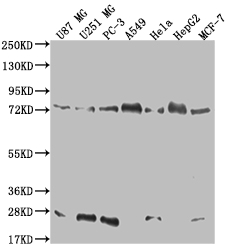The generation of the CAPN2 recombinant monoclonal antibody involves a well-defined process. Initially, B cells are isolated from an animal immunized with a synthesized peptide derived from human CAPN2, prompting an immune response and subsequent B cell harvest. Total RNA is extracted from these B cells, and cDNA synthesis is performed using reverse transcription. The CAPN2 antibody genes are then amplified via PCR, utilizing specific primers targeting the antibody constant regions. Subsequently, the amplified genes are cloned into an expression vector. Through transfection, the recombinant vector carrying the CAPN2 antibody genes is introduced into host cells to enable antibody production. The resulting CAPN2 recombinant monoclonal antibodies are harvested from the cell culture supernatant and purified using affinity chromatography. To validate their quality, the purified CAPN2 recombinant monoclonal antibody undergoes rigorous characterization, including ELISA and WB analysis, confirming their specific reactivity to human CAPN2 protein.






